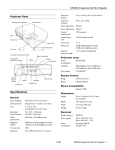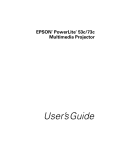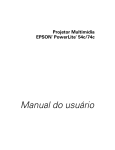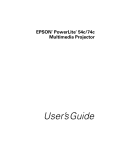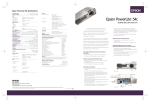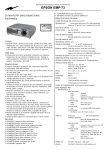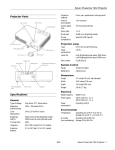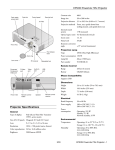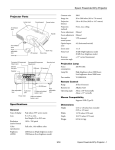Download Epson PowerLite 53c Specifications
Transcript
EPSON PowerLite 53c/73c Projector Remote control receiver Control panel Zoom ring Foot Focus ring Foot release lever Lens cap Foot Computer/Component Video port Monitor Out port S-Video port Remote control receiver Composite video port USB ports Projection distance 2.9 to 34.4 feet (0.9 to 10.5 meters) Projection methods Front, rear, upside-down (ceiling mount) Internal sound system 1 W monaural Optical aspect ratio 4:3 (horizontal : vertical) Zoom ratio 1 : 1.2 Noise level 36 dB (High brightness mode) 33 dB (Low brightness mode) Keystone correction angle ± 15° vertical (maximum) Projection Lamp Power consumption 165 W Lamp life About 1500 hours Part number V13H010L21 Remote Control Power inlet Audio1 port Security lock port RS-232C port Range 20 feet (6 meters) Battery CR2025 lithium Mouse Compatibility Audio2 L and R ports Specifications General Type of display Poly-silicon TFT active matrix 73: with MLA (Micro Lens Array) 53: without MLA (Micro Lens Array) LCD panels (3) Diagonal size: 0.7 inches (17.8 mm) Lens F=1.70 to 1.87, focal length=21.3 to 25.6 mm Resolution 1024 × 768 pixels (73) 800 × 600 pixels (53); (native formats) Color reproduction Full color, 16.7 million colors Brightness (ANSI) 53: 1700 lumens (High brightness mode) 1400 lumens (Low brightness mode) 73: 1500 lumens (High brightness mode) 1200 lumens (Low brightness mode) Supports USB Dimensions Height 3.4 to 3.8 inches (87 to 97 mm) Width 12.4 inches (315 mm) Depth 9.5 inches (240 mm) Weight 6.4 lb (2.9 kg) Electrical Rated frequency 50/60 Hz Power supply 100 to 120 VAC, 2.6 A 200 to 240 VAC, 1.3 A Power consumption Operating: 240 W Standby: 2.6 W Environmental Contrast ratio 500:1 Image size 30 to 300 inches (0.8 to 7.6 meters) Temperature Operating: 41 to 95 °F (5 to 35 °C) Storage: 14 to 140 °F (–10 to 60 °C) Humidity Operating: 20 to 80% RH, (non-condensing) Storage: 10 to 90% RH 11/02 EPSON PowerLite 53c/73c Projector - 1 EPSON PowerLite 53c/73c Projector Safety and Approvals United States FCC 47CFR Part15B Class B (DoC) UL1950 Rev. 3 Canada ICES-003 Class B CSA C22.2 No. 950-95 (cUL) CE Marking Directive 73/23/EEC, 89/336/EEC EN 55022, EN 55024 Compatible Video Formats The projector supports NTSC, PAL, and SECAM international video standards, as well as the monitor and HDTV display formats listed below. To project images output from a computer, the computer’s video card must be set at a refresh rate (vertical frequency) that’s compatible with the projector; see the following table for compatible formats. As noted below, some images are automatically resized to display in one of the projector’s “native” formats (such as XGA). In addition, the frequencies of some computers may not allow images to display correctly; see your computer’s documentation for details. Mode Refresh Rate (Hz) Resolution VGAEGA 70 640 × VGA—60 VESA—72 VESA—75 VESA—85 60 72 75 85 640 × 480* 640 × 480* 640 × 480* 640 × 480* SVGA—56 SVGA—60 SVGA—72 SVGA—75 SVGA—85 56 60 72 75 85 800 × 600* 1 800 × 600* 1 800 × 600* 1 800 × 600* 1 800 × 600* 1 XGA—43i XGA—60 XGA—70 XGA—75 XGA—85 43 60 70 75 85 1024 × 768* 2 1024 × 768* 2 1024 × 768* 2 1024 × 768* 2 1024 × 768* 2 SXGA1—70 SXGA1—75 SXGA1—85 70 75 85 1152 × 864 1152 × 864* 1152 × 864* SXGA2—60 SXGA2—75 SXGA2—85 60 75 85 1280 × 960* 1280 × 960* 1280 × 960* SXGA3—43i SXGA3—60 SXGA3—75 SXGA3—85 43 60 75 85 1280 × 1024* 1280 × 1024* 1280 × 1024* 1280 × 1024* UXGA—48i UXGA—60 48 60 1600 × 1200* 3 1600 × 1200* 3 MAC13 MAC16 MAC19—60 MAC19 MAC21 67 75 59 75 75 640 × 480* 832 × 624* 1024 × 768* 1024 × 768* 2 1152 × 870* 2 - EPSON PowerLite 53c/73c Projector 350* * 1 2 3 Mode Refresh Rate (Hz) Resolution NTSC NTSC 4:3 PAL M-PAL N-PAL PAL—60 SECAM 60 60 50 60 50 60 50 — — — — — — — HDTV (480i) HDTV (480p) HDTV (575i) HDTV (575p) HDTV (720p) HDTV (1080i) HDTV (1080i) 33.75/ 31.25 59.94 59.94 50 50 60 60 50 720 × 480* 720 × 480* 720 × 574* 720 × 574* 1280 × 720* 1920 × 1080* 1920 × 1080* The image is resized using EPSON’s SizeWise Technology. Resized on the PowerLite 73c only; native mode on the PowerLite 53c. Resized on the PowerLite 53c only; native mode on the PowerLite 73c. Resized on the PowerLite 73c only; not available on the PowerLite 53c. Computer Video Port Pin Assignments The Computer port is a female video RGB, 15-pin, mini-D-style connector. Here are its pin assignments: * 11/02 Pin no. Computer port 1 Red video 2 Green video 3 Blue video 4 GND 5 GND 6 Red GND 7 Green GND 8 Blue GND 9 Reserved 10 Synchronous GND 11 GND 12 SDA 13 Horizontal sync / composite sync 14 Vertical sync 15 SCL EPSON PowerLite 53c/73c Projector Positioning the Projector Before connecting the projector, you need to decide where to place it. The location you choose depends on the size of the room and what you are projecting. ❏ Place the projector on a sturdy, level surface, between 2.9 and 34.4 feet from the screen. If you place the projector below the level of the screen, you’ll have to tilt it up by extending the feet as shown. Tilting the projector upward causes the image to lose its rectangular shape, but the Auto Keystone feature corrects the distortion automatically. If the image does not regain its rectangular shape, the Auto Keystone feature may have been disabled. To turn it on, see page 5. ❏ Make sure there is plenty of space for ventilation around and under the projector. Leave at least 8 inches between the projector and a wall. ❏ Make sure the projector is within 6 feet of an electrical outlet or extension cord and within 5 feet of your computer and/or video source. ❏ Place the projector directly in front of the center of the screen, facing the screen squarely. Otherwise, your image will not be rectangular. Note It’s easier to position the projector when the screen is directly in front of the room. If the screen is placed diagonally in a corner, it’s much more difficult to aim the projector correctly at the screen and get a rectangular image. If you place the projector level with the bottom of the screen, the image will be rectangular and you won’t have to adjust it. If you place the projector higher than the bottom of the screen, the image will still be rectangular, but you won’t be able to fill the whole screen with the image. Use the figure below as a guideline to help you determine how far from the screen to place the projector. Image size generally increases with distance, but may vary depending on how you position the zoom ring and whether you have adjusted the image size with other settings. Starting Up the Projector Make sure your projector and other equipment are set up and connected correctly. Then turn on your projector, as described below, followed by any equipment you’ve connected to it. You can turn on your computer and video equipment in any order, but if you have both a computer and video source connected, you may have to switch to the desired source as described in step 5 on page 4. Turning On the Projector 30.1 to 34.4 feet 5.9 to 6.8 feet 2.9 to 3.4 feet Follow these steps to plug in and turn on the projector: 1. Remove the lens cap. Caution Do not use the projector with the lens cap in place. The heat generated by the lamp can damage the cap. 11/02 EPSON PowerLite 53c/73c Projector - 3 EPSON PowerLite 53c/73c Projector 2. Connect one end of the power cord to the projector’s power inlet. If a projected image fails to appear, see the next section for help. Once you see your image, turn to page 5 for instructions on focusing and making other image adjustments. When you’re done with your presentation, shut down the projector as described on page 6. Shutting down the projector correctly prevents premature lamp failure and possible damage from overheating. What To Do If You See a Blank Screen 3. Connect the other end to an electrical outlet. The power light on top of the projector turns orange, indicating that the projector is receiving power but not yet turned on. Wait until the light stops flashing, but stays lit orange. 4. Press the P Power button on top of the projector or on the remote control. Page down Page up Power Computer S-Video/Video Color Mode Menu A/V Mute Freeze E-Zoom Enter Auto Projector If you see a blank screen or a blue screen with the message No Signal after turning on your computer or video source, try the following: ❏ Make sure the cables are connected correctly. ❏ Make sure the power light is green and not flashing and the lens cover is off. ❏ Try restarting your computer. ❏ Press the Source button on top of the projector to select the correct source. (Allow a few seconds for the projector to sync up after pressing the button.) If you’re using a PC laptop: ❏ Hold down the Fn key and press the function key that lets you display on an external monitor. It may have an icon such as or it may be labelled CRT/LCD. Allow a few seconds for the projector to sync up after pressing it. Check your laptop’s manual or online help for details. ESC Remote control The power light flashes green as the projector warms up, and the projection lamp comes on in about 40 seconds. The power light stays green. On most systems, the or CRT/LCD key lets you toggle between the LCD screen and the projector, or display on both at the same time. ❏ Depending on your computer’s video card, you might need to use the Display utility in the Control Panel to make sure that both the LCD screen and external monitor port are enabled. See your computer’s documentation or online help for details. Warning Never look into the lens when the lamp is on. This can damage your eyes, and is especially dangerous for children. If you’re using a Macintosh laptop with OS 9.x or earlier: 5. Do one of the following: 1. From the Apple menu, select Control Panels, then click Monitors or Monitors and Sound. ❏ If you’re using a computer, turn it on or restart it. In a few moments, you should see your computer display projected. (Windows® only: If you see a message saying that it has found a plug-and-play monitor, click Cancel.) ❏ If you’re projecting a video, press the Source button on top of the projector or the S-Video/Video button on the remote control to switch to your video source. Then press the Play button on your DVD player or other device. 4 - EPSON PowerLite 53c/73c Projector You may need to set up your system to display on the projector screen as well as the LCD screen. Follow these steps: 2. Click the Arrange icon. 3. Drag one monitor icon on top of the other. If the Arrange option isn’t available, you may need to select one of the Simulscan resolution settings: 1. Click the Monitor icon, if necessary. 2. Select a Simulscan resolution. (Allow a few seconds for the projector to sync up after making the selection.) 11/02 EPSON PowerLite 53c/73c Projector If you’re using a Macintosh laptop with OS X: Adjusting the Height of Your Image You may need to set up your system to display on the projector screen as well as the LCD screen. Follow these steps: If the image is too low, you can raise it by extending the projector’s feet. 1. From the Apple menu, select System Preferences, then click Displays. 1. Stand behind the projector. Press the blue foot release levers and lift the front of the projector. This unlocks the feet. 2. Select VGA Display or Color LCD, click Arrange or Arrangement, and make sure Mirror Displays is checked. Adjusting the Image Once you see your image, you may need to make certain adjustments, as described in this section. Focusing and Zooming Your Image Foot Rotate the focus ring to sharpen the image. Focus ring 2. Once the image is positioned where you want it, release the levers to lock the feet in position. 3. To fine-tune the height of the image, rotate the projector’s feet. If the image is no longer rectangular after raising it, see the next section. Rotate the zoom ring to reduce or enlarge the image. Zoom ring You can also change the image size by moving the projector closer to or farther away from the screen. You can use the E-Zoom buttons on the remote control to zoom in on a portion of the image. See page 8 for instructions. Adjusting the Image Shape If the projected image isn’t rectangular or has a “keystone” shape, do one or more of the following: ❏ If your image looks like or , you’ve placed the projector off to one side of the screen, at an angle. Move it directly in front of the center of the screen, facing the screen squarely. ❏ If your image looks like or , the Auto Keystone feature has been disabled. You can correct this by turning on the Auto Keystone feature or by manually adjusting the keystone correction value. To turn on Auto Keystone, press the Menu button on the remote control. Use the directional buttons to select the Setting menu, then press Enter. Use the directional buttons to highlight Auto Keystone and to turn the feature on. Press the Enter button to save your changes, then exit the menu by pressing the Menu button. (Auto Keystone is not available when you’re using ceiling or rear projection.) To manually adjust the keystone correction value, press the or side of the Keystone button on the projector to correct the shape of the image. After correction, your image will be slightly smaller. You can also perform electronic keystone correction using the projector’s Setting menu. 11/02 EPSON PowerLite 53c/73c Projector - 5 EPSON PowerLite 53c/73c Projector Adjusting the Color Mode You may want to adjust the color mode to select a different setting that is appropriate for the image you’re projecting and the surroundings in which you’re projecting it. If you want to turn the projector on again, wait until the orange light stops flashing. Then press the P Power button. 4. Retract the front feet as shown. If you’re projecting computer images, the default color mode is Normal, which is appropriate for presentations in bright rooms. For video or S-Video images, the default color mode is Theatre, which optimizes video images using natural colors. You can also select one of these color modes: Color mode Description sRGB Use when projecting computer images conforming to the sRGB color standard (the default setting when projecting from a computer with analog video) Meeting Use when you want images projected using their original tints, without any color enhancements. 5. Replace the lens cap and unplug the power cord. Presentation Use when you’re projecting a presentation in a dark room. Caution Game Use when you’re projecting video games in a bright room. To change the color mode, press the Color Mode button on the remote control. The currently selected setting appears in the upper right corner of the screen. You can also use the projector menu system to select the Color Mode in the Video menu. To avoid damaging the projector or lamp, never unplug the power cord when the power light is green or flashing orange. 6. If you’re using a VCR or other video source, turn it off after you turn off the projector. 7. Disconnect all equipment, and store the projector in the soft case that came with it or in a protective case. Projector Status Lights Shutting Down the Projector The lights on top of the projector indicate the projector’s status and let you know when a problem occurs. When you’ve finished using the projector, follow the recommended procedure to shut it down. This extends the life of the lamp and protects the projector from possible overheating. Warning light Power light Note When the projector has not received any input signals for 30 minutes, it automatically turns off the projector lamp and enters “sleep mode.” This conserves electricity, cools the projector, and extends the life of the lamp. If you are done using the projector, unplug the power cord. If you want to start projecting again, press the P Power button. 1. If you’re using a computer, shut it down first. 2. To turn off the projector, press the P Power button on the projector or remote control. You see a confirmation message. (If you don’t want to turn it off, press any other button.) 3. Press the P Power button again. The power light flashes orange for about forty-five seconds as the projector cools down. When the projector has cooled, the orange light stays on and the exhaust fan shuts off. 6 - EPSON PowerLite 53c/73c Projector If the projector is not working correctly, first turn it off and unplug it. Then plug the power cord back in and turn on the projector. If this does not solve the problem, check the status lights on top of the projector and try the solutions recommended in the table on the next page. 11/02 EPSON PowerLite 53c/73c Projector Status lights Power light — — — — Orange Using the Remote Control Warning light Flashing red Flashing red (quickly) Red Flashing orange (quickly) Off Status Description Internal error There is an internal error in the projector. Turn the projector off and unplug it. Contact EPSON for help. Lamp failure The lamp is burned out or not installed correctly, or the lamp cover is open. Close the cover or replace or reseat the lamp, if necessary, as described on page 10. Overheating The projector has overheated and turned itself off. Let it cool for a few minutes, then turn it back on. Make sure there is plenty of space around and under the projector for ventilation. Also clean the air filter (see page 9). If it continues to overheat, you may need to replace the air filter. High temperature warning The projector is too hot. Make sure the temperature surrounding the projector does not exceed 95 °F and there is plenty of space around and under the projector for ventilation. Clean the air filter, if necessary. See page 9 for instructions. Sleep mode The projector is in sleep mode. You can unplug it or press the P Power button to turn it on. Flashing green Off Warming up The projector is warming up. Wait for the image to appear. Green Off Operating The projector is operating normally. Off The projector is cooling down. Wait for the light to Cooling down stay lit orange without flashing before unplugging it. Flashing orange Before using the remote control, pull out the tape from the battery tray as shown below. Tape When using the remote control, stand within 20 feet of the projector. Point the remote control either at the front or back of the projector or at the screen (the projector’s front sensor can detect signals bounced off the screen). Press the button for the function you want to use. See the following pages for instructions. Note Most of the projector’s features can only be accessed with the remote control. To avoid losing the remote control, place it in the remote control storage compartment beneath the side of the projector. Page down Page up Computer Menu S-Video/Video A/V Mute Power Color Mode Freeze E-Zoom Enter Auto ESC Switching Between Picture Sources If you’ve connected your projector to a computer and a video source, you can use the buttons on the remote control to switch between the different sources. ❏ Press the Computer button to select your computer source. ❏ Press the S-Video/Video button to select an S-Video or standard composite video source. After you select a source, the screen goes dark for a moment before the image appears. 11/02 EPSON PowerLite 53c/73c Projector - 7 EPSON PowerLite 53c/73c Projector Turning Off the Picture and Sound ❏ To double-click, press down twice on the Enter button. You can use the A/V Mute button on the remote control to turn off the image and sound and darken your screen. This is useful if you want to temporarily re-direct your audience’s attention without the distraction of a bright screen. ❏ To click and drag, press down on the Enter button and use the directional buttons to move where you want to drag. ❏ To turn off the picture and sound, press the A/V Mute button. The screen goes dark. ❏ To turn the image and sound back on, press the button again. Stopping Action ❏ To advance slides in a PowerPoint presentation in Slide Show mode, press the Page up or Enter button on the remote control. Press the Page down or Esc button to go back a slide. Note The Page up and Page down buttons work only when the USB mouse cable is connected. You can use the remote control to stop the action in your video or computer image. Replacing the Battery ❏ Press the Freeze button to stop the action and keep the current image on the screen. The sound will continue. When replacing batteries, take the following precautions: Caution ❏ Replace the battery as soon as it runs out. If the battery leaks, ❏ Press the Freeze button again to re-start it. Zooming Your Image You can zoom in on a portion of the image using the E-Zoom buttons on the remote control. 1. Press the + button to zoom in on your image. wipe away battery fluid with a soft cloth. If fluid gets on your hands, wash them immediately. ❏ Do not expose batteries to heat or flame. ❏ Dispose of used batteries according to local regulations. ❏ Remove the battery if you won’t be using the projector for a long period of time. ❏ Press the button repeatedly to enlarge it up to four times in 24 steps. Follow these steps to replace the battery: ❏ Press and hold the button to zoom in to the size you want. 1. Press the tab towards the center of the remote and slide the battery tray out of the remote control. 2. Use the directional buttons to pan around the screen if necessary. 3. Press the – button to zoom out. You can press the button repeatedly, or press and hold it to zoom all the way out. Press the Esc button to return to the original size. Using the Remote Control as a Wireless Mouse Tab 2. Remove the old battery and insert a CR2025 watch battery as shown. When you use the remote control as a wireless mouse, you can control your computer or click through slideshow-style presentations (such as PowerPoint) from up to 20 feet away. To control your computer with the remote, make sure you have connected the mouse cable between the projector and your computer. ❏ To move the mouse pointer on the screen, aim the remote at the screen and use the directional buttons to move the cursor. 3. Slide the battery tray back into the remote until it clicks into place. ❏ To click (or left-click), press the Enter button. ❏ To right-click, press the Esc button. 8 - EPSON PowerLite 53c/73c Projector 11/02 EPSON PowerLite 53c/73c Projector Cleaning the Lens Clean the lens whenever you notice dirt or dust on the surface. 3. To clean the filter, EPSON recommends using a small vacuum cleaner designed for computers and other office equipment. If you don’t have one, gently clean the filter using a very soft brush (such as an artist’s camel-hair brush). ❏ Use a canister of compressed air to remove dust. ❏ To remove dirt or smears on the lens, use lens-cleaning paper. If necessary, moisten a soft cloth with lens cleaner and gently wipe the lens surface. Caution Do not use glass cleaner to clean the lens. Cleaning the Projector Before you clean the case, first turn off the projector and unplug the power cord. ❏ To remove dirt or dust, wipe the case with a soft, dry, lintfree cloth. If the dirt is difficult to remove or if the filter is torn, replace it. 4. If you need to replace the filter, lift the tab on the filter cover and pull it upward to remove it. ❏ To remove stubborn dirt or stains, moisten a soft cloth with water and a mild detergent. Then wipe the case. ❏ Do not use wax, alcohol, benzene, paint thinner, or other chemical detergents. These can damage the case. Cleaning and Replacing the Air Filter Clean the air filter on the bottom of the projector after every 100 hours of use. If it is not cleaned periodically, it can become clogged with dust, preventing proper ventilation. This can cause overheating and damage the projector. 5. Remove the filter. 6. Install the new filter as shown below. Note When you get a replacement lamp for your projector, a new air filter is included. You should replace the filter when you replace the lamp. To clean the air filter, follow these steps: 1. Turn off the projector, allow it to cool down, and unplug the power cord. 7. Replace the filter cover by inserting the tabs and then pressing down the other end until it clicks into place. 2. Turn the projector upside-down. 11/02 EPSON PowerLite 53c/73c Projector - 9 EPSON PowerLite 53c/73c Projector 5. Use the screwdriver to loosen the two screws holding the lamp in place. The screws are deep inside the projector on the sides of the lamp. (You can’t remove the screws.) Replacing the Lamp The projection lamp typically lasts for about 1500 hours of use. It is time to replace the lamp when: ❏ The projected image gets darker or starts to deteriorate. ❏ The warning light is flashing red. ❏ The message LAMP REPLACE appears on the screen when the lamp comes on (after about 1400 hours of use). To maintain projector brightness and image quality, replace the lamp as soon as possible. Note To see how many hours the lamp has been used, see page 11. Contact your dealer or call EPSON at (800) 873-7766 in the United States for a replacement lamp. Request part number V13H010L21. In Canada, please call (800) 463-7766 to locate a dealer. Don’t remove these screws 6. Hold the lamp by the top, as shown, and pull the lamp straight out. Follow these steps to replace the lamp: 1. Turn off the projector, wait for the cool down period to end, then unplug the power cord. Warning This product includes a lamp component that contains mercury. Please consult your state and local regulations regarding disposal or recycling. Do not put it in the trash. 2. Allow the projector to cool down for at least one hour (if it has been on). 7. Gently insert the new lamp as shown below. Warning Let the lamp cool before replacing it. If the lamp breaks, handle the shards carefully to avoid injury. 3. Turn the projector upside-down to access the lamp compartment. 4. Use the screwdriver included with the replacement lamp to slide the edge of the lamp cover towards the side of the projector. Then lift off the cover. ) 1 Caution Do not touch the glass portion of the lamp assembly. Touching the glass could result in premature lamp failure. 8. Once the lamp is fully inserted, tighten its screws. 2 10 - EPSON PowerLite 53c/73c Projector 11/02 EPSON PowerLite 53c/73c Projector 9. Position the lamp cover so the arrows on the lamp cover align with the arrows on the projector. Then slide in the cover until it clicks into place. Optional Accessories EPSON provides the following optional accessories: 1 2 10.Now reset the lamp timer as described below. Resetting the Lamp Timer You must reset the lamp timer after replacing the lamp to clear the LAMP REPLACE warning message. Follow the directions below to reset the lamp timer: Product Product number Replacement lamp and air filter V13H010L21 Samsonite® wheeled soft case Soft shoulder bags (projector/laptop) ELPKS35 ELPKS43 ELPKS45 Distribution amplifier ELPDA01 Component video cable (VGA to component video) ELPKC19 Macintosh adapter set (includes monitor adapter and desktop adapter) ELPAP01 50-inch portable pop-up screen 60-inch portable pop-up screen 80-inch portable pop-up screen ELPSC06 ELPSC07 ELPSC08 High resolution document imager Motion presentation camera High resolution document camera ELPDC02 ELPDC03 V12H064020 Kensington® security lock ELPSL01 Ceiling mount Ceiling plate Suspension adapter ELPMB39 ELPMBFCP ELPMBADL 1. Turn on the projector. 2. Press the Menu button on the remote control. You see the main menu. Related Documentation 3. Use the directional buttons to highlight About, then press the Enter button. You see the following: CPD-15286 EPSON PowerLite 53c/73c User’s Guide CPD-15287 EPSON PowerLite 53c/73c Quick Setup Parts Price List PL-EMP53, PL-EMP73 Lamp : 1400H Reset Lamp Timer : Video Source Input Signal Frequency SYNC Polarity SYNC Mode Resolution Refresh Rate : : : : : : Execute Computer RGB H ---.--kHz V ---.--Hz H -----V ------ : -----: 0x 0 : 0.0 Hz 4. Press Enter to select the Reset Lamp Timer option. 5. Use the directional buttons to select YES and press Enter. 6. Press Esc to return to the main menu. 7. Press Esc again (or the Menu button) to exit the menu system. 11/02 EPSON PowerLite 53c/73c Projector - 11 EPSON PowerLite 53c/73c Projector 12 - EPSON PowerLite 53c/73c Projector 11/02












